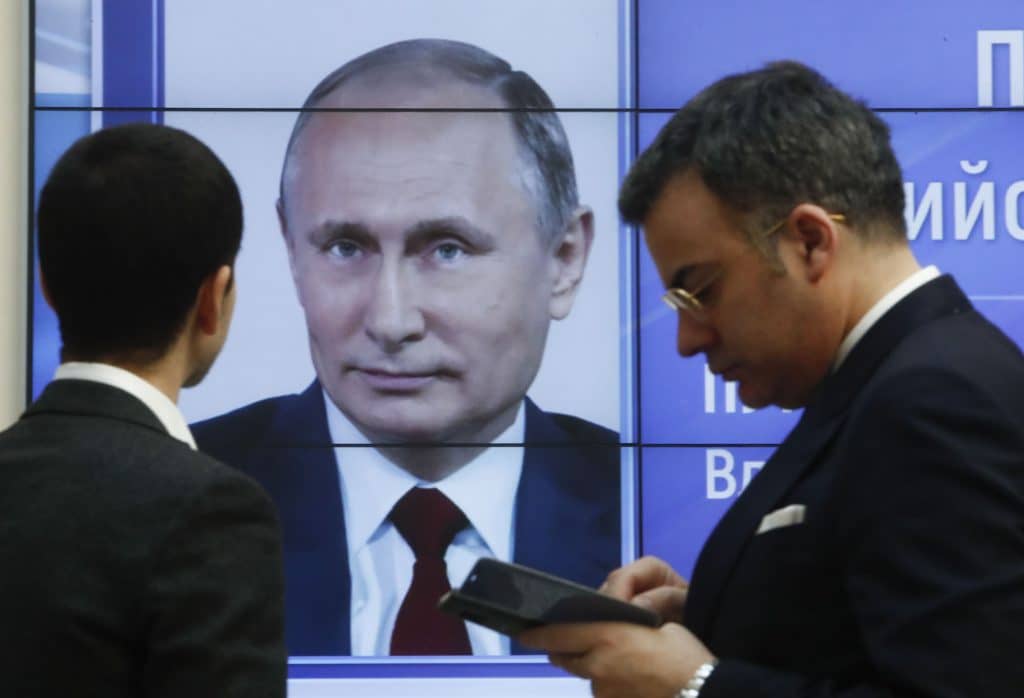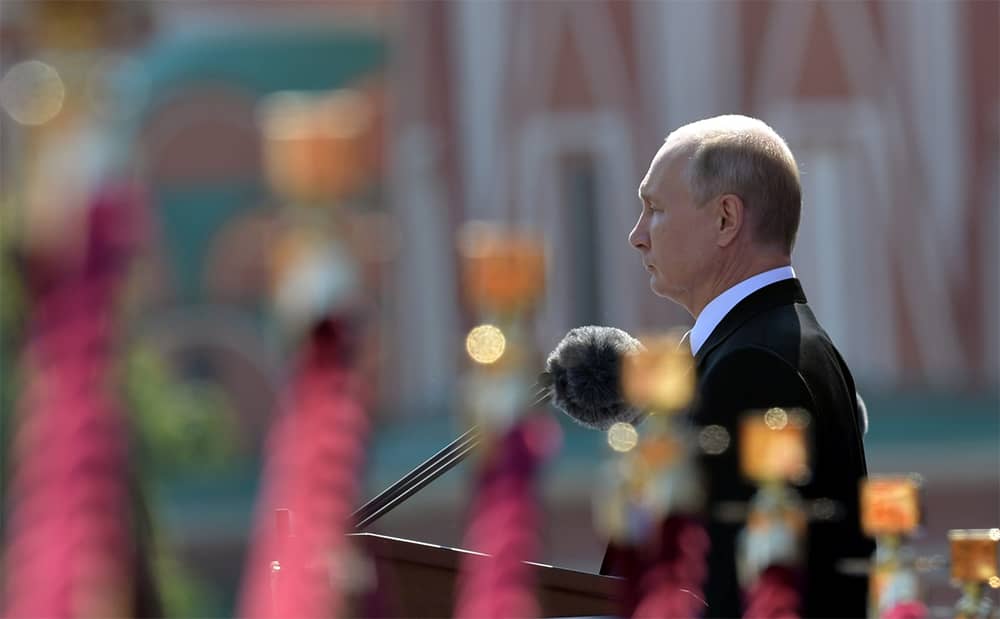Back in 2018, Time magazine chose to morph Vladimir Putin’s image with that of Donald Trump on its front page. In response, a seven-foot-tall portrait of Putin, titled “The Face of War,” made entirely of bullets, was put on display in New York. Its Ukrainian creators wanted to convey an anti-war message, as the shell casings were all from Ukraine’s 2014 Maidan uprising.
>> A Profile in Policy: Read more from Ksenia Svetlova
Putin did not react publicly to this daring work of art, but one should not rule out the possibility that he might have actually liked it. The bullet portrait projected boldness and power, qualities deeply appreciated and nurtured by the Russian president, who likes to pose with tigers and bears.
“I’d love for Putin to come here and show our leaders how it’s done,” an Israeli driver told me back in 2014, when Hamas had targeted central Israeli cities with its rockets. I have heard similar expressions many times across the Middle East, from Morocco to Lebanon. Russia’s many public displays of power—from annexing Crimea and making an incursion into Syria, to dealing with its critics and opposition—had contributed to shaping the image that Putin had desired for himself and his regime: strong and relentless. The implications of this imagery, and of the grudging or even outright approval it has gained in places around the world, run deep and extend well beyond the actual scope of Russian policies.
However, after 21 years of reign, President Putin is now dealing with multiple challenges—both political and economic. Donald Trump is no longer in office, and the combination of crippling Western sanctions, instability in the oil markets, and the coronavirus pandemic puts a heavy burden on the Russian state. Also, Russia’s advances in the Middle East and Africa are now encountering multiple challenges, as Western powers apparently have decided to fight back in Sudan, Iraq, the Central African Republic, and other points of contention. Vladimir Putin, who secured his hold on the presidency through 2036, is again discovering the limits of power.
Back in the USSR
When Vladimir Putin, a young prime minister and ex-KGB officer, became president back in 1999, Russia was a failed state. Its population was poor and often hungry. Its streets were crawling with criminals. Its diplomats abroad had no funds. Its army was weak and outdated, humiliated by defeats in the Chechen war. Its immediate neighbors, ex-Soviet republics, were eager to depart from the Soviet past and to integrate with the West and NATO. The latter, seen in Moscow as the eternal nemesis of the USSR and its successor state, the Russian Federation, was steadily expanding.
President Putin, who in 1999 was still talking about the “importance of transition to democracy,” had a plan. He had stabilized the economy and improved people’s living conditions, gaining substantial popularity. By 2003–2004, he turned to consolidating power, crushing many of his political opponents, as well as the almighty oligarchs.
Although in 1999 he said that he “cannot imagine my own country in isolation from Europe and what we often call the civilized world,” Putin was deeply wary of NATO’s expansion. His main concern was that the policies adopted by Clinton (in breach, one might say, of the promises Bush and Baker had given to Gorbachev and Yeltsin) would ultimately encompass Russia’s key strategic neighbors to the south. The leaders of Georgia and Ukraine were getting too close to the West to suit his taste.
Putin once said that the collapse of the USSR “was a genuine tragedy.” He knew full well that the Soviet empire was lost for good. True, many of his compatriots felt nostalgic for Soviet times. From a distance, they were perceived as better and simpler, as the past often is. But the Russian president felt sharply the significant difference between the once mighty USSR and modern Russia, a country with a medium-size economy and shrinking population. In this sense, Putin was more offended by President Obama’s dismissive comment during the 2012 presidential election campaign that Russia was just a regional power that lashed out at its neighbors due to weakness than by the comment of Republican presidential challenger, Mitt Romney, who had described Russia as the “number one geopolitical foe” of the United States.
A Man with a Plan
This combination of imperial ambitions, a sense of humiliation, and fear of NATO’s expansion resulted in a multilayered international strategy. Putin had a clear goal ahead of him: to prevent NATO from growing and to weaken the EU as much as possible, in order to provide Russia with freedom of action in its near abroad and to regain maximum influence in world affairs.
To secure these goals, Putin used hard power by initiating wars (with Georgia and Ukraine) and planting multiple “rusty nails” (in North Ossetia, Abkhazia, Lugansk, and Donezk—self proclaimed republics that enjoy strong Russian backing).
Putin also provided military assistance and weapons to foreign allies to ensure their stay in power and promote Russian interests in the respective regions—in Syria, Sudan, the Central African Republic, and Libya. This strategy gained Russia access to the warm waters of the Mediterranean (a dream of Tsar Peter the Great, Putin’s hero and the founder of his hometown, St. Petersburg). It also led to profitable military contracts and control over natural assets, such as oil and gas. These military campaigns were precise, deadly, and not nearly as costly as the Soviet incursion into Afghanistan, let alone the American entanglement in Iraq.
At the same time, Putin’s Russia developed effective soft power methods and sophisticated diplomacy. It became (almost) everybody’s friend—of Israel and Hamas, of Iran, Hezbollah, and the Gulf states, and of the Turks and the Kurds. Moreover, Putin found ways to sell Russian state-of- the-art weapon systems to Turkey, a NATO member, and to Egypt, a long-time American ally.
In Europe, Russia was quietly and effectively supporting ultra right-wing parties while building close ties with some Eastern European countries. It was blamed for interference in election campaigns in the United States and EU states, as well as some countries in Africa and the Middle East. Russia was no longer tied to any particular ideology; instead, it became a free rider.
The Limits of Power
To understand Putin’s foreign policy, it is important to remember how badly he was shaken by events in Berlin in 1989, when the wall was torn down and the demonstrators approached the KGB office where he was serving. According to his biographers, he had called his superiors, but they declined to send any help. A boy who grew up in a poor family, he turned to martial arts to empower himself; a servant of a mighty empire that ceased to exist, he ultimately turned into a Russian president who clearly believes that the blunt use of force is the only means to achieve his own goals and those of the country.

He sent soldiers to prevent neighboring countries from joining Western political and defense structures—and it worked. His “electronic army” acted as an agent of chaos, planting smear campaigns and increasing polarity—and up to a point, this strategy seemed to work as well. Yet at the end of the day, Putin’s Russia was successful mostly when the West was absent or uninterested. The Middle East became less of a priority for the US, and Russia was quick to land some gains there. The French had lost ground in African countries, and the Russians—much like the Chinese—became active there too.
However, now that President Biden seeks to reshape the “pro-democracy” camp and to restructure and empower NATO, Vladimir Putin might find himself fighting against a much more organized and consolidated adversary. The economic limits are easily recognized both at home and in the Middle East, an area where Russia had achieved substantial progress during the last few years. The military battle for Syria might be over, but without economic revival, it will never be complete; Russia is neither able to save Syria or Lebanon from economic collapse, nor will it be able to offer Sudan the generous aid package promised to it by the US or provide military aid to Egypt.
The limits of Vladimir Putin’s power are now visible in his backyard as well. Although Russia was one of the first countries to produce its own COVID-19 vaccine, its own population is not in a hurry to get that vaccine. Force can get people into submission, but it rarely builds trust.
Will Putin find answers to these complicated challenges that require not just power but solidarity, diplomacy, cooperation, and trust? For now, Putin is taking his country in the opposite direction—toward increased authoritarianism and international isolation.

